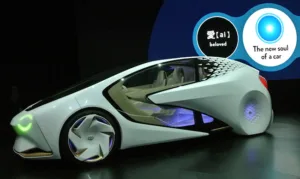When Display Monitor and Display Daily first started covering vehicular electronics at CES in depth, we focused on vehicular displays. That was reasonable for a news, analysis, and research organization that specializes in displays, but now, just three years later, that approach would look myopic.
Today, the excitement in the auto industry is on electric propulsion, connected vehicles, human-machine interfaces, and autonomous driving. Displays play a critical role, but we have to look at the systems first to see how displays can support the functions the systems are being designed to implement. That understanding allows us to see how displays can best be used, and what new displays are needed.
So, if parts of our vehicular CES coverage do not overtly mention displays, don’t be concerned. The displays are in there somewhere.
Toyota Strives for Warm and Fuzzy
On Press Day, the day before the CES exhibits opened, Toyata held a press conference that introduced an artificial intelligence system it calls Yu-i (YOO-EE). On the show floor was the Concept-i concept car, in which Yu-i is embedded.
“Yu-i is intended to enhance the quality of the relationship between the autonomous car and its human occupant”, said Toyota’s Bob Pratt, in his introductory comments. It identifies the driver, and assesses his or her mood and attentiveness, and interacts accordingly. The Concept-i car is “warm, energetic, and immersive,” said Carter. “It goes beyond HMI [the human-machine interaction] and on to the HM relationship. Yu-i learns from you as you drive. Car and driver become team mates.”
Carter then introduced Gill Pratt, CEO of the year-old Toyota Automotive Reseach Institute, which is dedicated to connected and automatous vehicles. The Institute hired over 100 people during its first year, and intends to hire at least 100 more durinig 2017. The Institute has its headquarters in Palo Alto, and a second facility in Cambridge, MA.
In the U.S. last year, auto deaths rose to 35,000. The Institute’s goal is the creation of “a car that is incapable of having an accident regardless of the ability of the driver.”
Pratt sumarized the five levels of automation as revised by the Society of Automotive Engineers (SAE) last September. Your correspondent has frequently referenced the four levels of automation as specified by the National Highway Traffic Safety Administration in 2013, but the SAE has added an interesting and useful level just underneath the full-automation level, which becomes L5 in the SAE specification. The new level, SAE L4, is also fully autonomous, but works only under specific circumstance and in specific locations: highways with freely flowing traffic when it’s not snowing, for instance. SAE L5, by contrast, is full automation under all conditions and in all places. Several companies, said Pratt, will have L4 over the next 10 years. (Audi said that it would have L4 by 2020 during the Nvidia event (NVidia Looking at GPUs to Enable Deep Learning and Autonomous Vehicles – Shows HDR Monitor)
SAE L3 is the level at which the car hands control over to the driver when it gets confused. SAE calls this a “request to intervene.” In this context, Pratt talked about the “problem of the disengaged driver” and how long it might take a disengaged drive to comply with the “request to intervene.” “It may be that Level 3 is as hard to achieve as Level 4,” Pratt said. Others have said that the challenge of having the driver switch from the task in which he’s engaged (teleconferencing or playing a game, for instance) to taking over control of the car is so great that it might be impossible to implement L3 safely.
Toyota is working on two systems: Guardian Angel and Chauffeur. Chauffeur mode is total autonomous driving. Guardian Angel technology, said Pratt, augments the human operator’s driving skills. The system will be able to learn over time, picking up on user’s driving habits so that it spots trends that could lead to accidents and advise the driver to make corrections to prevent a crash from occurring. This is an adding of artificial intelligence (AI) to the advanced driver assistant systems (ADAS) currently finding their way into a variety of vehicles. Toyota should be applauded for these efforts, but we shouldn’t forget that all major automotive OEMs and subsystem suppliers are moving in similar directions. –KIW
Toyota’s Concept-i show car, which incorporates the newly announced Yu-i artificial intelligence system. (Photo: Ken Werner)

